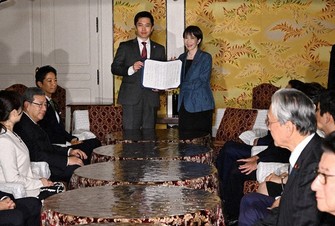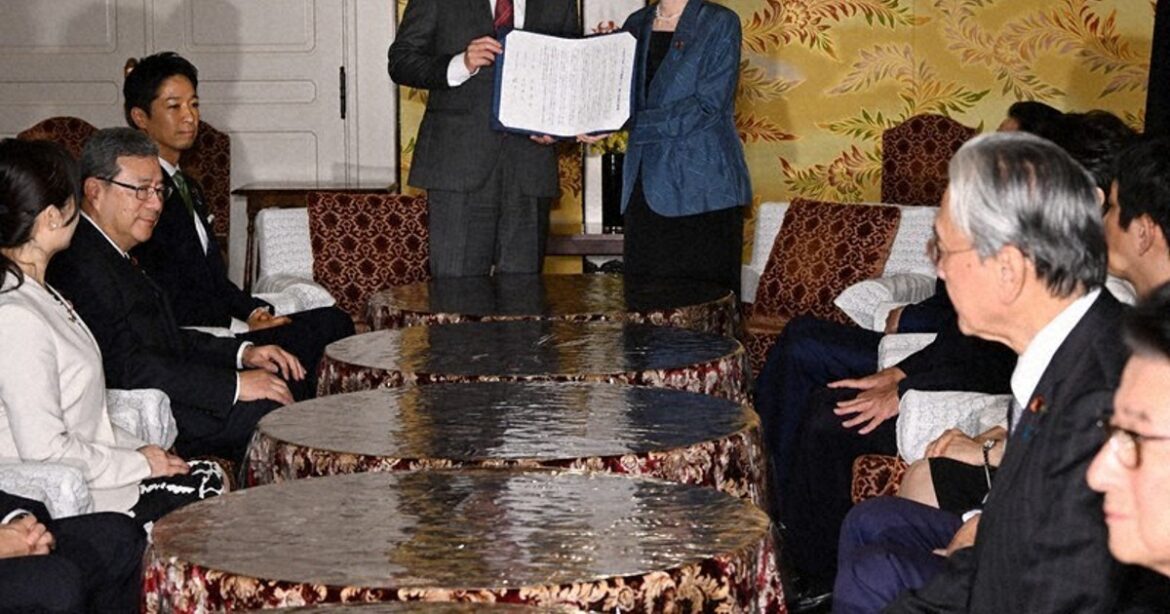
LDP President Sanae Takaichi, right, and Japan Innovation Party leader Hirofumi Yoshimura pose together with a signed coalition agreement in their hands, at the Diet building on Oct. 20, 2025. (Mainichi/Akihiro Hirata)
The ruling Liberal Democratic Party (LDP) and Nippon Ishin (the Japan Innovation Party, JIP) have agreed to legislate a plan next year to establish a “second capital” by developing a hub that can substitute for Tokyo, as the two parties are poised to form a coalition government. The LDP and JIP are set to initiate consultations to flesh out the details.
Questions remain as to whether the second capital initiative will truly contribute to rectifying the overconcentration in Tokyo. There are concerns that it may not lead to multipolar dispersion across multiple regions, raising the need for adequate discussions.
The second capital initiative was proposed by the JIP. According to the party’s draft outline, the second capital will take on the role of leading the country’s economic growth in addition to backing up the national capital function in the event of disasters. Applications will be filed by each prefecture, and once designated by the state, the second capital will be allowed to ease regulations and receive special tax treatment.
The overconcentration of the population and economic power in Tokyo has progressed, and even the government’s regional revitalization endeavors have failed to stem the tide. Strong political power is required to correct the excessive concentration. Granting a quasi-capital status to regions outside Tokyo could be one solution.
The JIP proposal, however, has a major flaw. It effectively limits candidates for a second capital to Osaka Prefecture. Making the so-called “metropolis plan” a reality is set as a prerequisite for qualifying as a secondary capital.
The metropolis initiative entails reorganizing major cities in prefectures into special wards to make them like Tokyo’s 23 wards. The JIP aimed to realize the “Osaka metropolis plan” by advocating for greater administrative efficiency, but the initiative was twice voted down in local referendums in the city of Osaka.
As for the reason for making the realization of the metropolis plan a condition for a second capital, the JIP explains that “because it is necessary to eliminate the duplication of administrative functions (between prefectures and ordinance-designated cities).”
However, no other prefectures besides Osaka are pursuing the metropolis plan, and major cities like Nagoya, Fukuoka and Sapporo find it difficult to join the initiative. Capital functions should be dispersed across multiple hubs, considering the balance of national territory. The JIP proposal is incompatible with this direction of multipolar decentralization.
Senior JIP officials are eager to call a third referendum. If they are aiming to create a new national system to help realize the metropolis plan, it would be defeating the purpose.
Regarding the decentralization of capital functions, the Democratic Party for the People has proposed a “special autonomous cities” concept. This involves separating major cities from prefectures and granting them strong authority. This approach can facilitate participation by multiple cities.
The significance and purposes of these plans, alongside the costs required for their implementation, should be examined more thoroughly. The proposals also concern the future shape of prefectures and municipalities. Rather than rushing to carry out a plan exclusive to Osaka, we urge for flexible consideration.


AloJapan.com